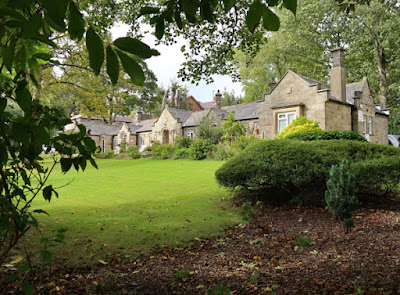 |
| A detail of a damaged gatepier to the entrance of Loxley House |
With my very brief investigation of the Malin Bridge Council School completed, I set off on my task for the rest of the day – to photograph various historic buildings in around the suburb of Wadsley for the British Listed Buildings website, starting with the sewer gas lamp at Oakland Road.
Although of no interest to this Language of Stone Blog, from here there is an excellent view of the topography that I had so far encountered since starting my walk at Walkley Bank Road, which illustrates the steepness of the hills in this part of Sheffield.
Walking up to Ben Lane, my first stop was the Dial House Club (1802), which I assume is named after the sundial that has been placed above the front door. It is built with sandstone from the Loxley Edge Rock that has considerable colour variation, from buff through shades of orange/brown to dark brown, but I didn’t get near enough to have a good look at its texture.
Continuing up Ben Lane, after noting the blackened very coarse grained sandstone at the lodge to Loxley House (1795), I went to see if I could get any photographs of the house and its service wing (1826), which are now converted into apartments and took a few quick snaps before one of the occupiers, leaning out of a top floor window, made an objection to me examining the stonework on ‘his’ private property.
Waiting for him to come down and give me a ‘stern lecture about how that I was on private property and I wouldn’t like to have someone taking photographs of my house’, I replied that ‘I lived in a humble terraced house that nobody except myself would want to photograph and not in a very interesting Grade II Listed building', shrugged my shoulders and retreated to the nearby football field to photograph the front elevation.
Retracing my steps to the bottom of Rural Lane, I carried on until I reached Wadsley stocks and took a photo, before continuing uphill to Stour Lane and photographing the Rose & Crown public house, dating to the mid C18 and providing another example of the Loxley Edge Rock.
My last stop on Rural Lane was another sewer gas lamp and then the house at No. 239, which is at the end of the adjacent terrace. It is Grade II Listed, like all the other buildings that I had photographed on my walk to date, but I have wondered why only this house in the terrace is considered to be of architectural significance.
Walking down Well Lane to Worrall Road, the next building on my list was the Wadsley Almshouses, a terrace of six single storey properties built c.1845 in the Tudor revival style but, being private property set back off the main road, I had to find a place in the adjoining churchyard from which to photograph them.
Looking at the stonework on my photographs, when zooming in to see the details, the finish of the horizontal tooling looks quite rough, as would be expected if the sandstone is very coarse grained. Tooled finishes like this tend to obscure the true colours within the stone, unless wetted, but I could now see what seems to be the typical colour variation of the Loxley Edge Rock – as also seen in the former school (1838) next door, which is now a clubhouse.
Stopping next at Wadsley parish church, which I shall describe in my next post, I made my way down to Wadsley Lane and up to The Drive to take a couple of photos of Wadsley House Club (1823) from the entrance gates. From this viewpoint, I could see that the local Loxley Edge Rock has not been used for the ashlar masonry and that the uniform buff colour suggests that it is probably from the Millstone Grit Group in Derbyshire, although my photos show some unusual bedding structures when enlarged.
Further down Wadsley Lane, I took a short diversion up Far Lane to photograph Wadsley Hall (1722) and Wadsley Hall Farmhouse, only to find that these were set back of the road and tall hedges obscured the views. Although I managed to get a couple of photos of Wadsley Hall, which is built in blackened ashlar sandstone, I could not see the farmhouse and therefore continued my walk down Wadsley Lane to Middlewood Road.











No comments:
Post a Comment